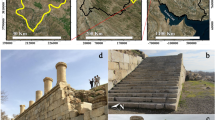Abstract
The objective of this work is to study the decay process involved in the historical Roman Chellah located in the Rabat city (Morocco). This monument is made up of porous calcarenite stone. Several samples, taken from altered and unaltered blocks, were analyzed by the water saturation, the mercury intrusion porosimetry techniques and using the scanning electron microscopy coupled to energy dispersive X-ray spectrometer (SEM–EDX). To perform a reliable chemical analysis, some samples were also analyzed by inductively coupled plasma-atomic emission spectroscopy (ICP-AES). The mercury porosimetry results show a bimodal porous network for this porous material, the deterioration process of these stones involved an increase in porous volume of about 2%. The lowest porosity observed in the unaltered block is connected to the presence of sparitic cement which causes a partial inter-granular porosity clogging. The highest porosity of the deteriorated block without crust is due to the increase in inter-granular space. SEM photographs of the unaltered sample show the presence of the porous primary grains, of ovoid forms and millimeter-length sizes, and of the secondary grains, of rhombohedric forms and micro size. Porosity is essentially located between the primary grains and can be completely clogged by secondary precipitations. Various forms of deterioration are observed on the altered samples such as the dissolution of the secondary grains edges, wells of dissolution and also the presence of argillaceous residues on the surface. This last was also detected by the ICP-AES and EDX analysis which show an increase of the silicon and aluminum contents toward the surface.








Similar content being viewed by others
References
AFPC-AFREM (1997) Détermination de la masse volumique apparente et de la porosité accessible à l’eau. Méthodes recommandées pour la mesure des grandeurs associées à la durabilité (Determination of apparent density and water porosity. Methods recommended for the sustainability measurements). Compte –rendu des Journées techniques. 11–12 Décembre Toulouse, France, pp 121–124
Akil M (1990) Les dépôts quaternaires littoraux entre Casablanca et cap Beddouza: Études Géomorphologiques et Sedimentologiques (Littoral quaternary deposits between casablanca and beddouza: geomorphological and sedimentological studies) Thèse de Doctorat Es- Science, Université Mohamed V Rabat, Maroc, p 419
Alves C, Sequeira Braga MA, Hammecker C (1996) Water transfer and decay of granitic stones in monuments. CR Acad Sci Paris t.323, series II a, pp 397
Azeroual M, Bouamar B, Bounakhla M, Doukkali A, ELwartiti M (2005) Action de la pollution atmosphérique sur les monuments historiques: caractérisation et estimation de l’état de dégradation des remparts de la médina de Salé (Action of the atmospheric polution on the historical buildings : characterization and estimate of the medina ramparts degradation). 3ème Journées des géosciences de l’Environnement. El Jadida 8, 9 et 10 Juin, Maroc
Azouaoui H, El Hatimi N, El Yamine N (2000) Plio-Quaternary formations of the Casablanca area (Morocco): sedimentological and geotechnical aspects. Bull Eng Geol Environ 59:59–74
Beck K (2006) Étude des propriétés hydriques et des mécanismes d’altération de pierres calcaires à forte porosité (Studies of hydrous properties and the mechanisms of porous limestones deterioration). Thèse de Doctorat, l’Université d’Orléans, Paris, France
Benavente D, Garcia del Cura MA, Garcia-Guinea J, Sanchez-Moral S, Ordonez S (2004) Role of pore structure in salt crystallisation in unsaturated porous stone. J Cryst Growth 260:532–544
Benboughaba R (2001) Etude Sédimentologique et Géophysique des formations littorales plio-quaternaires de l’axe Rabat-Kénitra (Maroc) (Sedimentological and geophysical studies of the plio-quaternary littoral formations of the Rabat-Kénitra axis). Thèse de doctorat, Université Mohammed V Agdal, Rabat, Maroc, p 233
Camuffo D (1995) Physical weathering of stones. Sci Total Environ 167:1–14
Carrio-Schaffhauser E (1987) Évolution des propriétés pétro physiques d’un calcaire: le rôle de la dissolution cristallisation dans une déformation cassante (Evolution of the petrophysical properties of a limestone : the role of dissolution crystallization in a breakable deformation). Thèse de l’Université de Aix-Marseille I, pp 291
Fripiat J, Chzaussidon J, Jelli A (1971) Chimie physique des phénomènes de Surface (Physical chemistry of surface phenomena). Edition Masson, Paris, p 387
Genkinger S, Putnis A (2006) Crystallisation of sodium sulfate: supersaturation and metastable phases. Environ Geol 52:329–337. doi:10.1007/s00254-006-0565-x
Goudie AS, Viles H (1997) Salt weathering hazards. Wiley, Chichester, p 241
Guéguen Y, Palciauskas V (1992) Introduction à la physique des roches (Introduction to rock physics). Hermann (ed) pp 299
Hammecker C (1995) The Importance of the petrophysical properties and external factors in the stone decay on monuments. Pure Appl Geophys 145(2):337–361
Lenormand R, Zarcone C, Sarr A (1983) Mechanisms of displacement of one fluid by another in a network of capillary ducts. J Fluid Mech 135:337–353
Prick A (1995) Dilatometrical behaviour of porous calcareous rock samples subjected to freeze-thaw cycles. Catena 25:7–20
Rijniers LA, Huinink HP, Pel L, Kopinga K (2005) Salt crystallization as damage mechanism in porous building materials—a nuclear magnetic resonance study. Magn Reson Imaging 23:273–276
Samaouali A, Laânab L, Geraud Y, Nounah H, Boukalouch M (2005) Chemical alteration of stones of monuments Chellah Roman. Paper presented at the first international meeting on Mediterranean Architectural Culture Heritage, in Collaboration with CICRP (Marseille, France). 26–28 September, Meknes, Morocco
Tiano P (1994) Biodeterioration of stone monuments. A critical review. In: Garg KL, Garg N, Mukerji KG (eds) Bio deterioration of cultural heritage, vol I. Naya Prokash, Calcutta, pp 301–321
Van Brakel JG, Modry S, Svata M (1981) Mercury porosimetry: state of the art. Powder Technol 29:1–12
Van TT, Beck K, Al-Mukhtar M (2007) Accelerated weathering tests on two highly porous limestones. Environ Geol 52:283–292. doi:10.1007/s00254-006-0532-6
Washburn EW (1921) Note on method of determining the distribution of pores sizes in a porous material. Proc Nat Acad Sci 7:115–116
Zaouia N, ELwartiti M, Baghdad B (2005) Superficial alteration and soluble salts in the calcarenite weathering. Case study of Almohade monuments in Rabat: Morocco. Environ Geol 48:742–747
Acknowledgments
This work was supported by the French-Moroccan cooperation within the project named (PAIVolubilis) No. MA/07/168. The authors would like to thank H. Ouaddari from CNRST for his technical assistance to perform ICP-AES analysis.
Author information
Authors and Affiliations
Corresponding authors
Rights and permissions
About this article
Cite this article
Samaouali, A., Laânab, L., Boukalouch, M. et al. Porosity and mineralogy evolution during the decay process involved in the Chellah monument stones. Environ Earth Sci 59, 1171–1181 (2010). https://doi.org/10.1007/s12665-009-0106-5
Received:
Accepted:
Published:
Issue Date:
DOI: https://doi.org/10.1007/s12665-009-0106-5




